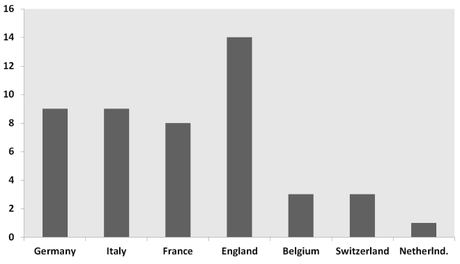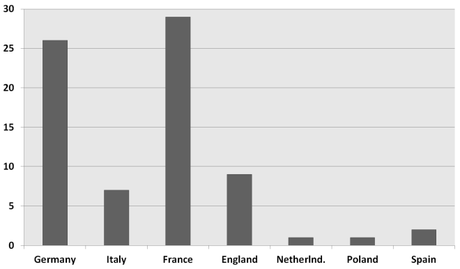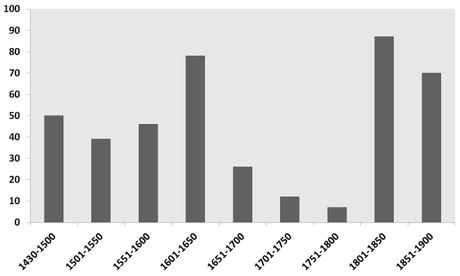Rhetoric’s fourth canon—memory—is synonymous with the art of memory. Today, the constructions of the ars memorativa are known as “memory palaces,” and they have been popularized by characters like Hannibal Lecter and Sherlock Holmes. The technique goes back to the Greek sophists, for it is mentioned in the Dissoi Logoi (circa 420 BCE) and is said to have been formalized by the lyric poet Simonides of Ceos (d. 468 BCE).
The art was elaborated upon by the Romans and went through various transformations during the middle ages (in fact, it has been argued by Frances Yates, Lina Bolzoni, and others that the Divine Comedy, with its carefully ordered visualizations of virtue and vice, presents nothing less than a Christianized memory palace). The art flourished during the early modern era despite the rise of print technologies and did not disappear from the intellectual scene until the late eighteenth century, demonstrating that until recently in history neither writing nor print were seen as substitutes for a strong memory, as they are today.
As part of my dissertation on the art of memory, I searched several bibliographies of rhetoric, eventually compiling 423 memory treatises. 261 were published between 1430 – 1800; 162 were published in the nineteenth century. Bibliographies consulted were Lawrence D. Green and James J. Murphy’s Renaissance Rhetoric Short-Title Catalogue, 1460-1700; Heinrich F. Plett’s English Renaissance Rhetoric and Poetics: A Systematic Bibliography of Primary and Secondary Sources; George S. Fellows’ “Bibliography of Mnemonics,” published in A.E. Middleton, Memory Systems New and Old; and the British Library’s Incunabula Short Title Catalogue. At the bottom of this post, there is a download link for an Excel file listing all treatises published between 1430 – 1800, with Date, Title, Author, Author’s Nationality, and Place of Publication. (I’ll upload the nineteenth century treatises at a later date.)
Of course, that number 423 does not represent 423 unique treatises; many are second or third editions of an original work. But it was important to count multiple editions because I was interested primarily in the rise and fall of this genre’s (the memory treatise’s) popularity over time.
Here are some graphs that have ended up in my dissertation. The first graph displays all memory treatises published, by country, between 1551 – 1600. The second displays all memory treatises published, by country, between 1601 – 1650. The third displays memory treatises published in all countries, by half-century.

Memory treatises published, by country, 1551-1600

Memory treatises published, by country, 1601-1650

Memory treatises published in Europe, per half-century
There are several prominent trends in these graphs that I analyze in the dissertation, but the one I want to call attention to here is the drop in English memory treatises between the end of the sixteenth century and the beginning of the seventeenth. Between the years 1551 – 1600, England keeps pace with the publication of memory treatises on the continent. Between the years 1601 – 1650, however, with memory treatises flourishing in France and Germany, the publication of treatises in London slows down greatly. This is made especially curious by the fact that 1601 – 1650 marks the entrance of London as a major publication center. Before 1600, England was producing fewer than 160,000 books per year, compared to 700,000 per year in France and Germany and 800,000 in Italy. After 1601, however, England caught up to the continental powerhouses, publishing ~700,000 books annually from 1601 – 1650 (Buringh and Van Zanden, “Rise” 418). Yet the genre of the memory treatise saw no corresponding rise in publication numbers. Indeed, looking at the total number of memory treatises published in Europe by half-century, the lack of London contributions between 1601 – 1650 appears even more remarkable, for those decades correspond to artificial memory’s most popular period, judging by raw publication counts.
So what could account for the sudden lack of interest in the art of memory in England at the turn of the sixteenth and seventeenth centuries?
One reason, I argue, is that the entire point of the art of memory is to furnish one’s mind with elaborate and emotionally charged mental imagery. The art operates upon the notion that remediating knowledge into the semiotics of sight and dimension makes them easier to remember and to access. However, this was not a precept destined to be popular in an England that had come to be dominated by iconoclastic Anglo Protestants, because imagery, in Protestant England, was synonymous with Catholic religious practice, idolatry, and all manner of irrational superstition—holy relics, indulgences, the veneration of saints. Perhaps the crucial event for understanding this rejection of imagery is Henry VIII’s dissolution of the monasteries, an episode that saw a literal smashing of the idols—“an orgy of iconoclasm,” in Leanda de Lisle’s words (Tudor 244)—with books burned, altar-pieces ripped out, stained glass windows shattered, and art destroyed. The destruction wrought during this period was driven as much by opportunistic plundering and political intimidation as by abstract theological conflict, but the result was the same. Writing not long after those events, the antiquarian John Stow would write that the Protestants “judged every image to be an idol” (qtd. de Lisle 244), resulting in the loss of some ninety percent of medieval art housed in England (de Lisle, “A sad reminder”). In such an environment, precepts for affective imagery are dead on arrival. As one Protestant minister wrote in condemnation of the art of memory: “A thing faigned in the mind by imagination is an idol.”
In Art of Memory, Yates analyzes a few early modern texts suggesting that many well-educated English Protestants had a distaste for the art of memory on iconoclastic grounds. I am glad that her argument remains intact (and is in fact strengthened) when taking a more “distant” bibliographic view.
If Anglo iconoclasm did indeed expedite the abandonment of the art of memory in England, then this history provides a good example of the influence of changing social environments on rhetorical practice. All rhetorical precepts are “creatures of historical circumstance,” Nan Johnson has written. Studying the historical transformation of those precepts is as valuable to understanding cultural evolution as is studying the transformation of literary form.
